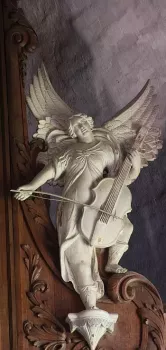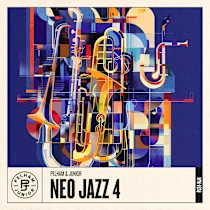
P2P | 27 September 2024 | 21.95 GB
Leens的Petruskerk风琴是由格罗宁根风琴制造者Albertus Anthoni Hinsz(1704-1785)于1733/34年建造的,取代了旧的乐器。Hinsz风琴有27个音站和三个部分:蹄工、蹄工和踏板,完成于1734年12月。Hinsz借用了兹沃勒Michaël教堂管风琴的设计。与其他欣茨乐器(如Midwolda或Harlingen)相比,Leens风琴以其辉煌的声音而闻名。因此,就声音而言,它最接近施尼格的传统。装饰华丽的风琴箱,雕刻和雕塑是由Theodorus van der Haven和Caspar struiwright制作的。对于一个小教堂来说,这个管风琴太大了。
风琴在1843/44年由Geert Pieters Dik翻新,然后在1867年由Petrus van Oeckelen在教堂的新塔楼建造后修复,并在1922年由Jan Doornbos修复。在每种情况下,更换一个或多个止损点。1922年的修复还包括更新farade管道和风力供应。Petruskerk本身在1948年至1952年被修复。这架风琴在教堂修复期间被包裹起来保护,由风琴制造商Mense Ruiter重新演奏。但当时,人们立刻意识到,这尊珍贵的乐器已经严重受损,有必要进行全面修复。这是由风琴制造商Gebr在1963年至1967年进行的。乌得勒支的Van Vulpen。当时,恢复了原来的处置。修复后的乐器于1968年4月26日落成。多年来,对这一修复进行了一些修正,例如降低风压(现在是68毫米)。1981年,增加了踏板耦合器。在2010年,气质被改为Neidhardt II(“Dorf”)。
2019年,Orgelmakerij Reil B.V.被委托进行重大维护,其中包括用五个楔形波纹管重建整个风力供应,以及修饰其他风琴部件,包括Calcanten铃。从1922年开始,三个Prestanten的前管被重新发声,以更好地匹配乐器的其余部分,并且在必要时对其余管道的发声进行了纠正。修改了1968年的《舍普曲》。然而,Neidhardt II调谐被维持,风压几乎保持不变。当风箱和管道在2020年在Heerde的车间时,雕刻被修复并由Tico Top完成。Hinszorgel Leens基金会的成员随后为风琴外壳和配件打蜡,包括风琴栏杆。2021年5月初,修复后的管风琴隆重揭幕。
Sonus Paradisi曾两次录制该管风琴:2017年,在Reil修复之前,以及2022年修复后。主要通道的麦克风位置和录音技术是相同的,因此可以使用样品集提供的特殊ODF直接比较恢复前后的声音。这个ODF使用户能够实时地在乐器的两种声音之间来回切换。这种能力显示了器官研究和历史编纂采样技术的独特潜力;这样的直接比较在其他情况下是不可能的,尤其是在使用真实管道的现实世界中。
The organ in the Petruskerk in Leens was built 1733/34 by the Groningen organ builder Albertus Anthoni Hinsz (1704-1785), replacing an older instrument. The Hinsz organ has 27 stops and three divisions: Hoofdwerk, Rugwerk and Pedaal, and was completed in December 1734. Hinsz borrowed the design of the instrument from the organ of the Michaël church in Zwolle. The Leens organ is distinguished for its brilliant sound, compared to other Hinsz instruments, such as Midwolda or Harlingen. It is therefore closest to the Schnitger tradition in terms of sound. The richly decorated organ case, the carvings, and the sculptures were made by Theodorus van der Haven and Caspar Struiwigh. The organ is unusually large for a small church.
The organ was renovated in 1843/44 by Geert Pieters Dik, then in 1867 it was repaired by Petrus van Oeckelen after the construction of the new tower of the church, and in 1922 it was restored by Jan Doornbos. In each case, one or more stops were replaced. The 1922 restoration also included renewal of the façade pipes and wind supply. The Petruskerk itself was restored in 1948-52. The organ, which had been encased for protection during the church restoration, was made playable again by the organ maker Mense Ruiter. But at that time it became immediately apparent that the precious instrument had suffered to such an extent that a total restoration was necessary. This was carried out in the years 1963-67 by the organ builders Gebr. Van Vulpen in Utrecht. At that time, the original disposition was restored. The restored instrument was inaugurated on April 26, 1968. Over the years there were some corrections to this restoration, such as lowering the wind pressure (which is now 68mm). In 1981, there was a pedal coupler added. In 2010, the temperament was changed to a Neidhardt II (“Dorf”).
In 2019, a major maintenance was entrusted to Orgelmakerij Reil B.V. This included a reconstruction of the entire wind supply with five wedge bellows, as well as retouching other organ parts, including the Calcanten bell. The front pipes of the three Prestanten from 1922 were revoiced to better match the rest of the instrument, and the voicing of the rest of the pipework was corrected where necessary. The composition of the Scherp from 1968 was revised. However, the Neidhardt II tuning was maintained and the wind pressure remained almost the same. While the wind chests and pipework were in the workshop in Heerde in 2020, the carvings were restored and completed by Tico Top. Members of the Foundation Hinszorgel Leens then waxed the organ case and accessories, including the organ balustrade. In early May 2021, the restored organ was festively inaugurated.
Sonus Paradisi has recorded the organ twice: In the year 2017, before the Reil restoration, and in 2022 after the restoration. The mic positions and recording technique were the same for the main channels, and therefore it is possible to directly compare the sound before and after the restoration using a special ODF supplied with the sample set. This ODF gives the user the ability to switch back and forth between the two sounds of the instrument in real time. This capability shows the unique potential of the sampling technique for organ research and historiography; such a direct comparison is impossible otherwise, especially not in the real world with the real pipes.






